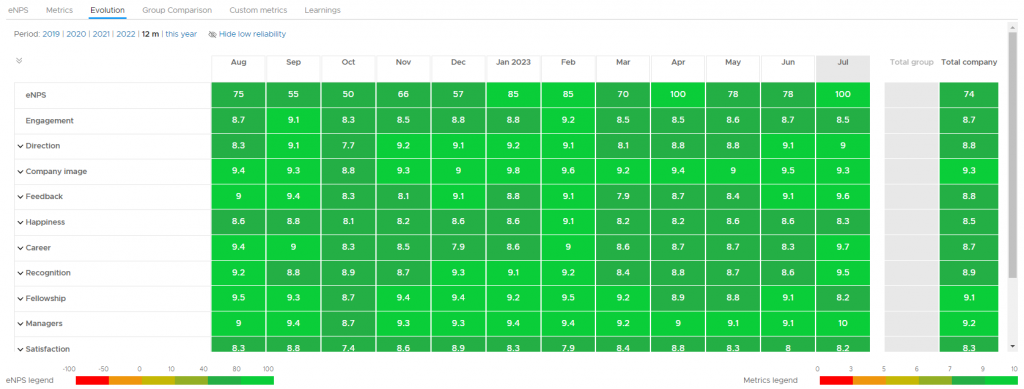Employee engagement is a crucial aspect of any successful organization. Engaged employees are more satisfied, motivated, productive, and likely to stay with the company for the long term. But, how do you measure employee engagement?
In this article we provide you with a step-by-step guide to measure employee engagement. In the following words, we’ll walk you through the process of effectively measuring employee engagement to gain valuable insights and drive positive change in your organization.
You will also have access to a list of 32 questions to include in your employee engagement surveys.
The 8 steps to measure Employee Engagement correctly
- Define YOUR employee engagement
- Identify your KPIs
- Choose an employee engagement measuring tool
- Design your survey
- Launch your survey
- Analyze the results of your survey
- Share the results and take action
- Monitor the progress and optimize
1. Define YOUR employee engagement
Before you start measuring employee engagement, you must have a clear understanding of what employee engagement means for your company. Employee engagement can be defined as the emotional commitment and dedication that employees have towards their company, work, colleagues, and company goals. Define a specific definition of what employee engagement means to you and align it with your organizational values and goals.
2. Identify your KPIs
To accurately measure employee engagement, you first need to identify the KPIs that you’ll have as a reference. There are 10 main employee engagement metrics & KPIs you can’t overlook. You can also conduct surveys, focus groups, and interviews to gather employee feedback and identify the factors that influence your engagement levels.
3. Choose an employee engagement measuring tool
There are various methods and tools you can use to measure employee engagement. But remember that it is key to choose an employee engagement tool and methods that aligns with your company goals, the resources you have available, and your company culture.
With Nailted you can launch pulse surveys, custom surveys and check-ins, promote employee recognition among employees, organize one-on-one meetings, and get all your people analytics centralized in one place. All of this together will help you measure your employee engagement levels in the right way – and fully automated!
Nailted is a very popular option as it allows you to obtain quantitative and qualitative data regardless of the number of employees you have in your company and always respecting their anonymity.

4. Design your survey
When designing an employee engagement survey, ensure it covers all the KPIs you defined in step 2. We suggest using a combination of closed-ended questions with rating scales and open-ended questions to gather both quantitative and qualitative data. Include questions about job satisfaction, leadership, feedback, and other areas. You have a list of questions covering all relevant areas in the section “32 questions to measure employee engagement”.
Remember to keep your surveys as concise and easy to understand as possible. It’s also important to ensure anonymity to encourage honest responses. If you have problems designing anonymous surveys, contact us, we can help you!
5. Launch your survey
Once the survey is designed, it’s time to send it to your employees. You can opt for an employee engagement tool that helps you automate the sending and collection of results such as Nailted. Communicate the purpose of the survey, emphasize the anonymity of responses, and provide a deadline for completion – we recommend a couple of weeks. Encourage employees to participate and assure them that their feedback will be used to drive positive change within the organization.
6. Analyze the results of your survey
Use an employee engagement tool to collect all your survey results and automatically transform them into KPIs. This will save you days of work. Then it’s time to analyze the data to gain meaningful insights.
A few tips for analyzing survey results:
- Try to identify trends, patterns, and correlations.
- Pay attention to those areas with the highest and lowest engagement scores.
- Compare results across different groups or teams – you can configure them as you wish in Nailted.
- Look for common themes in open-ended responses to get a deeper understanding of employee sentiments.
7. Share the results and take action
Once you have analyzed the data, share the survey results with the entire organization. Communicate the key findings, both positive and negative, and highlight areas for improvement. Involve employees in the process by asking for ideas and suggestions for improving engagement. Develop an employee engagement action plan based on the survey results, setting clear goals and timelines for implementing changes.
If you think this is not for you because you work remotely? Wrong! There are many virtual activities to work on employee engagement that you can use.
8. Monitor the progress and optimize
Employee engagement is an ongoing process, so it’s important to continuously monitor progress and make adjustments on your employee engagement strategies as needed. Regularly track your employee engagement KPIs and compare them with previous surveys to evaluate the effectiveness of your initiatives.
Seek feedback from employees and make necessary modifications to your action plan. Employee engagement is a journey, and it requires commitment and continuous improvement.
32 Questions to measure Employee Engagement

Employee engagement plays a crucial role in the success and growth of any company. Employee engagement is often confused with job satisfaction, but in this section you will see that it goes beyond that!
Employee engagement is supported by several factors that together help define the level of employee engagement in a company. These are the 7 most critical factors:
- Job satisfaction
- Corporate values
- Work environment
- Feedback & communication
- Leadershio & fellowship
- Employee recognition
- Professional development
As we’ve already mentioned, to effectively measure employee engagement, companies often resort to various tools and strategies, mainly composed of surveys. By asking the right questions, these surveys can give us valuable insights into the level of engagement among our employees.
Take a look at these 32 questions that can feed your employee engagement metrics with relevant data and help you better measure employee engagement.
Let’s dive in and explore the questions that matter when it comes to measuring employee engagement!
The 4 must-ask questions on employee engagement
- Do you consider yourself an ambassador of [company name]?
- Would you nominate [company name] for the “best place to work” awards?
- Would you recommend the products or services offered by [company name]?
- Would you be a customer of [company name]?
Questions on job satisfaction
- On a scale of 0-10, how much would you recommend [company name] as a good place to work?
- Would you be happy to be a client of your company, or to buy the products/services that it offers?
- Do you feel that you can maintain a healthy balance between your work and your personal life?
- How satisfied are you with your level of autonomy at work?
Questions on corporate values
- Are you proud of what we do in [company name]?
- In [company name], are professionalism and results valued above personal relationships?
- Do you like the mission and purpose of [company name]? Do they motivate you?
- Are there unnecessary rules and regulations in [company name]?
Questions on work environment
- Do you feel like you’re part of the team?
- Does [company name] encourage employees to be innovative even knowing that some initiatives may not work?
- Do you think that the work environment reflects the culture of [company name]?
- If a friend asks you if [company name] is a good place to work, would you say it is …?
Questions on feedback & communication
- The feedback you receive, does it help you grow and improve yourself?
- Do you feel that you can express your opinion about [company name] freely?
- Are you satisfied with the frequency with which you meet with your manager to give you feedback?
- If you had a new idea for your company, what are the chances of you sharing this idea?
Questions on leadership & fellowship
- Is your direct manager transparent with the team?
- Do you believe your manager is aware of the main problems that exist in the team?
- When you ask your colleagues for help, do they take the time to help you?
- Do your colleagues accept opinions that are different to theirs?
Questions on employee recognition
- Are you satisfied with the frequency with which your work is recognized?
- Does [company name] encourage you to recognize each other’s work?
- When you receive recognition for your work, do you think it is honest and meaningful?
- Does [company name] celebrate your achievements and learning?
Questions on professional development
- Do you have the opportunity to improve your skills?
- Does [company name] put at your disposal a development plan designed to improve your skills?
- Do you feel that you have enough freedom to decide how to do your job?
- Is your work a challenge for you?
Measuring employee engagement the right way is critical to understanding the needs and concerns of your employees. By following the step-by-step process and including the above questions in your surveys, you will be able to effectively measure employee engagement. In doing so, you will gain valuable information and create a more engaged and productive workplace.
An engaged workforce is the backbone of a thriving company, so investing effort in measuring employee engagement properly is worthwhile. Remember, you don’t have to do it manually, if you want to learn how to measure employee engagement efficiently, contact us, we’ll be happy to help!










